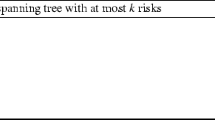Abstract
We develop a method to determine the topology of a network that interconnects a number of token rings using source routing bridges. The purpose is to compute a topology that provides low response delays for network users at a minimal cost of bridge installations. We formulate this network design problem as a mixed binary integer linear program. We develop effective heuristic algorithms. The algorithms exploit the topology and routing solutions of the linear programming relaxation in a sophisticated manner which we believe is new in the literature. The model incorporates performance issues, such as network stability, bridge overflow, back pressure effect and broadcast storm, that are specific to the underlying communication technology. By formally incorporating these performance issues, we tighten the model formulation and improve the quality of the LP bound considerably. Computational results are reported for problems with up to 20 token rings and 190 potential bridge locations.
Similar content being viewed by others
References
ASTRAL (Alliance for Strategic Token Ring Advancement and Leadership). (1996). ‘An Educational Guide to Token Ring.’ (http://www.astral.org/astralwp.html).
Boisson, N., O. Strilka, and A. Sutter. (1994). ‘A Simulated Annealing Algorithm for LANs Interconnection Networks Design.’ In Proc. 2nd Int'l Conf. Telecom. Syst., Vanderbilt Univ., Nashville, TN.
Bux, W. (1985). ‘Performance Issues.’ In G. Goos and J. Hartmanis (eds.), Lecture Notes in Computer Science 184: Local Area Networks: An Advanced Course. Berlin, Germany: Springer-Verlag, pp. 108–161.
Bux, W. and D. Grillo. (1985). ‘Flow Control in Local Area Networks of Interconnected Token Rings,’ IEEE Trans. Commun. 33, 1058–1065.
Clarke, L.W. and G. Anandalingam. (1995). ‘A Bootstrap Heuristic for Designing Minimum Cost Survivable Networks,’ Computers and Operations Research 22, 921–934.
Ersoy, C. and S.S. Panwar. (1993). ‘Topological Design of Interconnected LAN/MAN Networks,’ IEEE J. Select. Areas Commun. 11, 1172–1182.
Fetterolf, P.C. and G. Anandalingam. (1991). ‘Optimizing Interconnection of Local Area Networks: An Approach Using Simulated Annealing,’ ORSA J. Computing 3, 275–287.
Fetterolf, P.C. and G. Anandalingam. (1992a). ‘A Lagrangian Relaxation Technique for Optimizing Interconnection of Local Area Networks,’ Operations Res. 40, 678–688.
Fetterolf, P.C. and G. Anandalingam. (1992b). ‘Optimal Design of LAN-WAN Internetworks: An Approach Using Simulated Annealing,’ Annals Operations Res. 36, 275–298.
Fratta, L., M. Gerla, and L. Kleinrock. (1973). ‘The Flow Deviation Method: Approach to Store-and Forward Computer Communication Network Design,’ Networks 3, 97–133.
Gerla, M. and L. Kleinrock. (1988). ‘Congestion Control in Interconnected LANs,’ IEEE Network 2, 72–76.
Gondran, M. and M. Minoux. (1988). Graphs and Algorithms. New York: Wiley.
Gupta, S. and K.W. Ross. (1991). ‘Performance Modeling and Optimization of Networks of Bridged LANs,’ Queueing Syst. 9, 113–132.
IBM. (1991). Optimization Subroutine Library: Guide and Reference. Release 2, Kingston, NY.
IEEE. (1998). IEEE 802.5 Documents. (http://p8025.york.microvitec.co.uk/802.5/documents/).
Information Handling Services. (1993). Vendor Master Directory and Vendor Catalogs on CD-ROM. Englewood, CO.
Kaefer, F. (1995). ‘Algorithms for Designing Survivable LAN-Interconnection Networks Using Transparent Bridges.’ Ph.D. Thesis, Univ. of Iowa, Iowa City, IA.
Kaefer, F. and J.S. Park. (1995). ‘A Method for Interconnecting LANs with Survivability Considerations.’ In Proc. 3rd Int'l Conf. Telecom. Syst., Vanderbilt Univ., Nashville, TN.
Kaefer, F. and J.S. Park. (1998). ‘Interconnecting LANs and a FDDI Backbone Using Transparent Bridges: A Model and Solution Algorithms,’ INFORMS J. Computing 10, 25–39.
LeBlanc, L., J.S. Park, V. Sridhar, and J. Kalvenes. (1996). ‘Topology Design and Bridge-Capacity Assignment for Interconnecting Token Ring LANs: A Simulated Annealing Approach,’ Telecom. Syst. 6, 21–43.
Lee, F.C.Y., G. Anandalingam, and L. Clarke. (1995). ‘Design of Survivable LAN-LAN Internetworks with a Hierarchical Topology.’ Working Paper 94–20, Dept. of Sys. Eng., Univ. of Pennsylvania, Philadelphia, PA.
Love, R.D. and J.J. Lynch. (1997). ‘Token Ring Migration: A White Paper.’ IBM Networking Hardware Division, Research Triangle Park, NC. (http://www.hstra.com/articles.html).
Magnanti, T.L., P. Mirchandani, and R. Vachani. (1995). ‘Modeling and Solving the Two Facility Capacitated Network Loading Problem,’ Operations Res. 43, 142–157.
Monma, C.L. and D.F. Shallcross. (1989). ‘Methods for Designing Communications Networks with Certain Two-Connected Survivability Constraints,’ Operations Research. 37, 531–541.
Nishida, T., M. Murata, H. Miyahara, and K. Takashima. (1986). ‘Congestion Control in Interconnected Local Area Networks.’ In R.L. Pickholtz (ed.), Local Area and Multiple Access Networks. Rockville, MD: Computer Science Press, pp. 107–136.
Padberg, M.W., T.J. Van Roy, and L.A. Wolsey. (1985). ‘Valid Linear Inequalities for Fixed Charge Problems,’ Operations Res. 33, 842–861.
Park, J.S., R. Bartoszynski, and W.A. Rosenkrantz. (1995). ‘Stability of p-Persistent CSMA/CD’ ORSA J. Computing 7, 149–159.
Park, J.S., and K. Kang. (1993). ‘Delay Analysis of Multidimensional Queuing Process in CSMA/CD Local Area Networks,’ Telecom. Syst. 1, 217–242.
Park, J.S., L. LeBlanc, and B.H. Lim. (1996). ‘Interconnecting Remote LANs Using SMDS: A Model and solution algorithms.’ In Proc. 4th In'l Conf. Telecom. Syst. Nashville, TN.
Perlman, R. (1992) Interconnections: Bridges and Routers. Reading, MA: Addison-Wesley.
Soha, M. and R. Perlman. (1988). ‘Comparison of Two LAN Bridge Approaches,’ IEEE Network 2, 72–76.
Sridhar, V. (1994). ‘Optimal Design of Interconnected Local Area Networks.’ Ph.D. Dissertation, Univ. of Iowa, Iowa City, IA.
Sridhar, V., B. Gavish, and J.S. Park. (1995). ‘Reliable Interconnection of LANs Using Source Routing Bridges.’ In Proc. 3rd ORSA Telecom. Conf., Boca Raton, FL.
Taylor, M. (1997). ‘High Speed Token Ring: A Technology White Paper.’ Madge Networks, San Jose, CA, (http://www.hstra.com/articles.html).
Valiant, L.G. (1979). ‘The Complexity of Enumeration and Reliability Problems,’ SIAM J. Computing 8, 410–421.
Wolsey, L.A. (1989). ‘Strong Formulation for Mixed Integer Programming: A Survey,’ Math. Programming 45, 173–191.
Yen, J.Y. (1971). ‘Finding the k Shortest Loopless Paths in a Network,’ Management Sci. 17, 712–716.
Ziff-Davis Publishing. (1993). Data Sources-the Complete Computer Product Book: Hardware and Data Communications Volume. New York, NY.
Author information
Authors and Affiliations
Rights and permissions
About this article
Cite this article
Sridhar, V., Park, J.S. & Gavish, B. LP-Based Heuristic Algorithms for Interconnecting Token Rings via Source Routing Bridges. Journal of Heuristics 6, 149–166 (2000). https://doi.org/10.1023/A:1009622011925
Issue Date:
DOI: https://doi.org/10.1023/A:1009622011925




